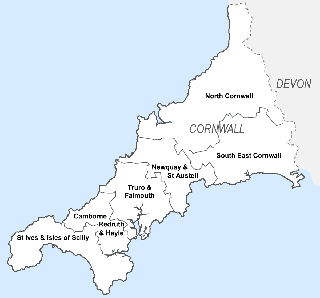Protecting the Roseland
 Last month I wrote about the need to build more affordable homes for local people. In this article I would like to consider a closely related issue, how we can best protect our precious landscape.
Last month I wrote about the need to build more affordable homes for local people. In this article I would like to consider a closely related issue, how we can best protect our precious landscape.
Some would argue that these two aims are irreconcilable – either you build homes or protect green fields. I don’t agree.
I have always found our shared ‘can do’ attitude to be one of the many joys of living in Cornwall.
This is never more so than when it comes to housing. Residents from villages and towns across my constituency all tell me the same positive message that when it comes to development, they want local people to be able to continue to live in the area where they grew up and the local countryside preserved for their children and grandchildren to enjoy. Often residents have some very sensible suggestions as to how these goals can be delivered, perhaps building five new homes on the site of the old garage, or taking the village green into community ownership to prevent future development and to preserve the view.
This is why, when it comes to the competing needs of housing and environment, I look to local people to strike the right balance. In 2010 I stood on a Conservative Manifesto which promised to put communities in charge of planning. I have been delighted to see this commitment carried through by Conservatives in Government, despite the constraints of governing as part of a Coalition.
 The National Planning Policy Framework (NPPF) took effect in March 2012 and has ensured that decisions about housing and landscape in Cornwall are made in Cornwall.
The National Planning Policy Framework (NPPF) took effect in March 2012 and has ensured that decisions about housing and landscape in Cornwall are made in Cornwall.
All Whitehall set housing targets have been abolished and it is now for Cornwall Council, through its Local Plan, to decide on Cornwall’s planning future, including the number and types of homes to meet local needs. Around 80{c8c3b3d140ed11cb7662417ff7b2dc686ffa9c2daf0848ac14f76e68f36d0c20} of Local authorities have approved Local Plans for their area, some with housing numbers significantly lower than those imposed by central government before 2010 and with an increased proportion of affordable homes.
These local authorities have had to adhere to strict guidelines imposed by the NPPF concerning the need to protect the landscape. The NPPF states that all planning decisions should
‘contribute to and enhance the natural and local environment’ with brownfield land being prioritised for development and high quality farmland protected. Heritage Coast and Area of Outstanding Beauty designations remain in place, with developments only permitted in these areas under exceptional circumstances.
 It is very disappointing that Cornwall Councillors have yet to agree a Local Plan for Cornwall, based on these conserving principles and seizing the new freedoms to deliver the right quantity and quality of new affordable homes for local people. Until a robust Local Plan is in place Cornwall is not fully protected against speculative development.
It is very disappointing that Cornwall Councillors have yet to agree a Local Plan for Cornwall, based on these conserving principles and seizing the new freedoms to deliver the right quantity and quality of new affordable homes for local people. Until a robust Local Plan is in place Cornwall is not fully protected against speculative development.
These new freedoms do extend to calculating the right number of houses to meet Cornwall’s future housing needs. Earlier this year I asked the Planning Minister for an assurance that Cornwall Council could use additional, realistic and appropriate data to agree a housing target based on local needs, rather than simply seeking to replicate past building rates. In response the Minister confirmed that Cornwall Council could choose to take this course of action, providing it had the evidence to prove how Cornwall was going to meet its local housing needs. A number of Councils have now successfully adopted this approach in other parts of the country.
Whilst Cornwall Councillors have been slow to act, the Roseland has of course been blazing a trail. The second tier of community controlled planning, neighbourhood planning, is being pioneered here with the Roseland Neighbourhood Plan going from strength to strength. Whilst Cornwall Council’s Local Plan will set the number and type of new homes in Cornwall, Neighbourhood Plans enable communities to determine how these policies will be applied locally. It represents a wonderful opportunity to build the Roseland we want to see and I will continue to do all I can to support the Roseland Plan Steering Group.
Of course planning doesn’t only involve homes, over recent years local people have righty been concerned by the effect of large scale wind turbines and solar developments on the Roseland’s landscape. As with housing I have been pressing for local people to be able to set their own balance between new wind and solar energy generation and landscape protection. Ministers listened and have released new planning guidance instructing local authorities to give greater weight to community views and concerns about landscape impact when considering onshore wind and solar applications. More information about the new guidance can be found here: http://www.sarahnewton.org.uk/news/communities-be-put-driving-seat-onshore-wind-turbine-decisions
 This month my fellow Cornish Conservative MP George Eustice, now serving as a Farming Minister, has made it clear that ‘solar farms’ are not farms at all. Announcing the abolition of farming subsidy payments on fields covered by solar panels George said:
This month my fellow Cornish Conservative MP George Eustice, now serving as a Farming Minister, has made it clear that ‘solar farms’ are not farms at all. Announcing the abolition of farming subsidy payments on fields covered by solar panels George said:
“We want to see our good farmland dedicated to growing quality food and crops and do not want to see its productive potential wasted and its appearance blighted by ugly solar farms, as farming is what our farms are for and it is what keeps our landscape beautiful.
“I am committed to food production in this country and it makes my heart sink to see row upon row of solar panels here in Cornwall where once there were fields of crops or grassland for livestock to graze. Some developers have attempted to claim that farming can continue underneath solar panels but these are sham arguments which we reject.
“Solar panels are best placed on the 250,000 hectares of south facing commercial rooftops where they will not compromise the success of our agricultural industry. That is why we are scrapping farming subsidies for solar fields.”
I welcome George’s actions; in addition to community led renewable energy planning we need to direct taxpayer subsidy for renewable energy in a fair and transparent way, targeted at the most effective energy sources. I continue to be very excited by the potential of marine energy, a field in which Cornwall is leading the way.
I am very much looking forward to further discussing what we are doing to protect the Roseland’s landscape at Gerrans Memorial Hall on the 13th November from 19.30. This event is kindly being hosted the Friends of Pendower Beach and will feature a question and answer session on landscape protection with myself and some of the other candidates who will be standing for election in Truro and Falmouth next year. Do come along if you can!

Thank you Sarah for being true to your very sensible policies for local planning. These days Cornwall Council Planning department seems all at sea, and as you know we had an almighty battle earlier this year to make them respect both local opinion and the already existing legal protections supposedly granted by Conservation Area and AONB status. Let’s hope the well thought out Roseland Plan succeeds and will act as a good, sane example for policies for the whole of Cornwall.